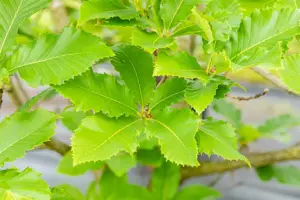Syringa vulgaris 'Miss Ellen Willmott' - 25-30 CM C3
Syringa vulgaris 'Miss Ellen Willmott' - 25-30 CM C3
Bulletpoints
* suitable for flowering hedges
* the flowers are highly favoured by bees, bumblebees and hoverflies
* cut flower
* fragrant flowers
* tolerates pruning
* easy to care for
* heat-tolerant, urban climate-resistant, wind-resistant, smoke-hardy, heat-loving, deer-resistant
Bark
Striped, torn bark.
Growth habit
Common lilac 'Miss Ellen Willmott' is upright, dense and branched in structure.
Water
The plant has a medium water requirement.
Pruning
Pruning, ideally in July, is advisable for this plant.
Location
Preferred location in a sunny to semi-shady position.
Soil
Normal soil.
Planting time
Container plants can be planted all year round, except when the soil is frozen and in summer heat (over 30°C).
Tasks
- Fertilise: In the period from March to April
- Watering: In the period from May to September
- Pruning: July.
Care
- A slow-release fertiliser can be used in spring. This releases the nutrients slowly and continuously so that the plant is evenly supplied over a longer period of time.
- Lilacs flower on biennial wood, so the plant should be thinned out after flowering or plants that have grown too large should be pruned.
Flower
The creamy white flowers are double and appear in panicles from May to June. They grow to around 12 - 15 cm tall and are pleasantly fragrant.
Use
Pruning, solitary, park, bee pasture, hedge, scented garden
Root
Syringa vulgaris 'Miss Ellen Willmott' is a taproot and, depending on the soil, forms runner-forming, strongly spreading roots.
- Article number55
-
EAN codeSYVMEWIL-2025030C3
- Latin nameSyringa vulgaris 'Miss Ellen Willmott'
- catalogLandscape shop



